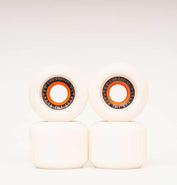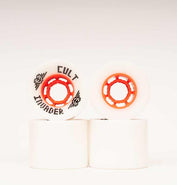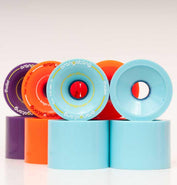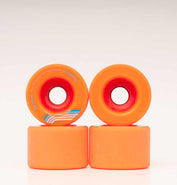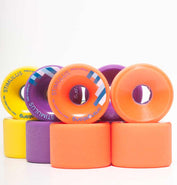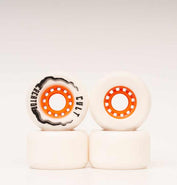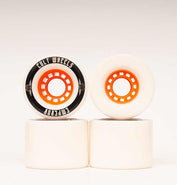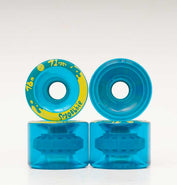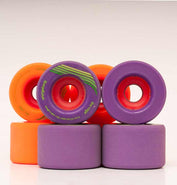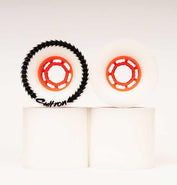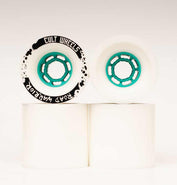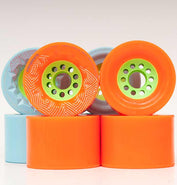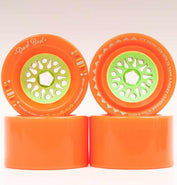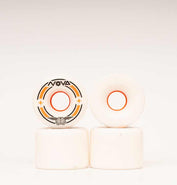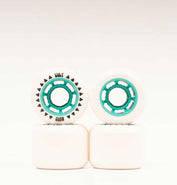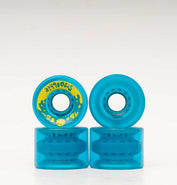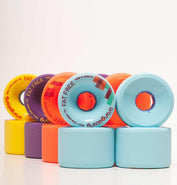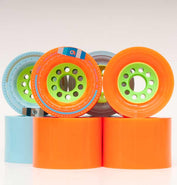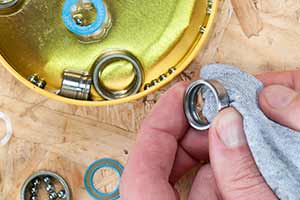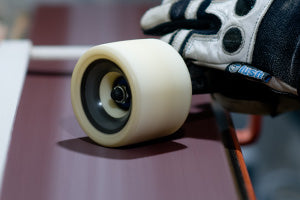Longboard Wheel Guide
What kind of wheels do I need for my longboard?
We get asked this every day! To really know the answer, you need to understand a little about what makes a wheel grip, roll and slide the way it does. Read on with our handy guide!
Skateboard and longboard wheels are made from the petrochemical called Polyurethane.
"Urethane" or "thane" for short, it's an awesome material which is bouncy, grippy, and comes in all sorts of cool colours.
Back in the day they used to be made from rubber, UHWMPE plastics (like sliding pucks), clay or even metal - thankfully things have moved on since then...
-
Wheel Shapes
-
Diameter
-
Contact Patch and Wheel Width
-
Edges and Lips
-
Cores and Core Position
-
Urethane rebound, durometer ratings, grip and speed over different surfaces
-
Stoneground vs Race Finish Running Surface
-
Flatspots, Coning and Egging
-
Progressive Grip and why you need it
-
What wheels are best for...
1. Wheel shapes
The profile of a wheel (as you look at it from the front or back) affects the way a wheel rides way more than you may realise. The three things to consider are Diameter, Contact Patch and Edges.
Wheel Diameter
The diameter or size of a wheel is pretty important.
In conventional wisdom, larger = faster and smaller = quicker acceleration. This is because smaller wheels have less inertia to overcome to get spinning and larger wheels have a higher road speed for the same rotational speed. This makes larger wheels faster as friction losses from your bearings increase with rotational speed so there is less drag from your bearings etc at any given road speed. There is, however, more to it for us longboarders.
The main difference you will notice between bigger and smaller wheels is that you can roll much faster over rough surfaces when you are on bigger wheels, and a few mm can make all the difference.
This has to do with the radius of curvature of the outside of the wheel compared to the obstacles you are trying to roll over (rough surfaces looks like thousands of little rocks to something as small as a skate wheel). The more gentle the curve the larger stuff you can handle.
This sort of stuff is not a concern to shortboarders who tend to stick to perfectly smooth skate parks and paved areas etc. Wheels go up to 101mm using regular urethane, but there are issues of wheelbite with low decks and turny trucks.
The other thing that comes into play is weight.
Obviously a heavier (bigger) wheel will roll better - but it will also have more inertia whilst going sideways.
What this actually means is larger wheels are generally harder to break grip and harder to control whilst sliding - hence most freeride wheels are around the 70mm mark, or have huge vented cores to save weight. There's a balance to be struck with having enough urethane on the core to give you a long lasting wheel, and a wheel size that isn't too sluggish whilst sliding.
What diameter wheels do I need for my longboard?
65mm and smaller
These are the fastest accelerating wheels out there, and also the best choice if you want to slide a lot at slower speeds. A smaller wheel like this slides better (although it might not last as long), and is way less prone to wheelbite on topmount cruiser setups. Smaller, lighter wheels are more nimble and also keep your deck height lower.
- Faster acceleration
- Lighter weight and relatively large core makes smaller wheels ideal for sliding
- Less likely to get wheelbite
- May not last as long as larger wheels
- Not as smooth and plush over rougher surfaces as a bigger wheel
66mm-70mm Diameter
This is pretty much the ideal size for a longboard wheel. Big enough to carry speed and feel plush on rougher surfaces, but small enough to accelerate and slide nicely, around the 70mm mark has been the standard size longboard wheel for ever.
- A good balance of speed, weight and smoothness makes for a great all-round size
- Not really likely to get wheelbite, but you might need to watch out with very loose or lower angle trucks on topmount longboards
- A plusher ride than a smaller wheel - not the ultimate in smoothness, but good enough for most longboarding situations
- Last longer than smaller wheels
71mm-73mm diameter
Things are starting to get faster now. Wheels this size are capable of higher speeds than their smaller cousins, and will hold momentum over rougher surfaces way better. This size is awesome for freeriding and higher speeds downhill skating, where you need a larger, solid wheel under your board.
- A good medium-large size for all kinds of downhill skating and freeriding
- Watch out for wheelbite - if you're freeriding, you'll likely need some big wheelwells or cutouts in your deck to keep things low and safe.
- A plush, smooth ride over rougher surfaces make this size ideal for cruising around
- You should expect to get a bit more life out of wheels this big - assuming you can keep them round!
74mm and Larger Diameter
Big, soft wheels will make your board seriously fast - though their size and weight will take longer to spin up to speed, once they get going, your board will roll over anything and hold a line over the roughest of surfaces! Look out for large cores to keep weight down and increase wheel rigidity to prevent flatspots.
- Big, soft monsters like this are great for super-fast downhill skating, and also make ideal pushing/communting wheels
- Wheelbite can be a real issue above 75mm - use these on a drop-through or restrict your trucks with clever bushing choice to minimise this
- More urethane means they often don't slide as well as smaller wheels, though a bigger core really helps a lot here
- Wheels this size will last for ages... especially with a big core
- Did we mention the big core yet? Super-wide cores have become something of a resurgent trend in large longboard wheels recently, with good reason - you wheels will slide more predictably, roll faster and last longer. A bit of air venting also helps stop your bearings overheating!
Wheel width and contact patch
The contact patch is the width of the wheel that contacts the ground when you're riding.
The wider the contact patch the more grip and less progressive the slide, but the less likely you are to get flatspots.
Narrow wheels are looser and slidier, but usually wear down faster and flatspot/egg easier as there is the same weight over a smaller area of wheel - so more pressure on the urethane.
You can narrow down your selection of wheels by "Width" in the "Longboard Wheels" Section of the shop, which will give you an approximation of the contact patch width.
Wheel Edges and Lips
The edges or lips of the wheel affect how it slides sideways across the road and how much grip it has. There are three kinds of edges:
Sharp lips
A square or sharp edge profile wheel tends to be very grippy. They're best for downhill, slalom and fast carving, where you need as much grip as you can get.
They have so much grip because the square "lips" of the wheel and distort over bumps in the road surface. After a bit of carving or drifting you will "blow" the edges of your wheels out - you'll round those square lips off.
Wheel designs that rely on their lips to create grip will suddenly become much easier to slide at this point.
Round edges
A radiused or round edged wheel is what you need for sliding and hard carving.
As the wheel is shaped with a nice circular edge it travels across the road sideways much better than a square or bevelled wheel, but it also lets go a bit earlier and more progressively.
This makes it easy to loose speed by drifting the board sideways or sliding at slower speeds, but not so good if you need loads of grip.
A bigger radius will last longer as the wheel wears down, and will be less grippy than a smaller radius.
2. Cores and core position
Most quality wheels out there have a plastic core that the bearings sit in.
The core spreads the heat through the wheel and stops the bearings (which get super hot at speed) melting the Urethane. It is VERY BAD when this happens - melting (or "puking") a wheel can be very dangerous!
Exposed cores work better for heat dispensation than internal cores. Keep your bearings clean and lubed...

You don't want this to happen...
The core also helps to maintain the circular integrity of the wheel, which helps to prevent egging and flatspots.
A wheel with a big core is more likely to stay spinning when sliding sideways, so it'll stay round for much longer than a coreless wheel.
Cored wheels are also faster on smooth surfaces, as there is less urethane to compress and rob you of your speed - but this means that large-cored soft wheels can be quite chattery over rougher surfaces.
However, on a smooth surface, a very large core gives a lot of support to the urethane, allowing high roll speeds and ultra-smooth slides- good for bigger race wheels.
Think of a low-profile car tyre on an alloy hub... more grip, more speed, tighter handling.
The position of the core in the wheel also makes a big difference to how the wheel grips, slides and wears.
Centerset cores
Where the core is in the middle of the wheel as you look down on it.
This has the advantage of making the wheel "flipable" should you start to cone your wheels.
Centerset wheels also wear down slowly, as the load (your weight!) is spread evenly across the width of the wheel.
However, a centerset core position is not the most efficient design for creating grip, or producing a good slide.
Recently some manufacturers have tried to compensate for this by creating super wide shapes with centerset wheels, for maximum grip and a long life on rough roads.
Backset cores
Where the core is in flush with the back of the wheel.
This creates a very slidey, progressive wheel, as the inside edge of the contact patch (the bit that does all the work) is very supported.
If you want a freeride wheel, we think backset is the way to go. The disadvantage is that they will cone faster.
Offset cores
Where the core is in between the back edge and the center.
The maximum grip point of the wheel shape is usually somewhere between the inside edge and center of the wheel - so some of the grippiest wheels available are sideset.
Exact core positioning to create maximum grip is a black art, and many other factors (lip thickness, inner edge profile, contact patch width etc) come into play when creating maximum grip.
3. Urethane rebound, durometer ratings, grip and speed over different surfaces
Skate wheels have come a long way since the steel or clay wheels of the past.
Anyone who has ridden both these and modern urethane wheels will vouch for the increased speed, better grip and overall improved ride quality of urethane wheels.
This is mainly down to the ability of urethane wheels to rebound, ie return to their original shape quickly after being distorted.
Modern urethane is significantly "higher rebound" than older urethane - you can test the rebound or a wheel by dropping it on the floor and seeing how high it bounces.
This quality is used to minimise the rolling resistance of the wheel.
When you put your weight on the board, the wheels compress slightly at the leading edge as the wheel rolls on to the road, and then as the wheel roll on the back edge rebounds pushing against the road and returning the energy used to compress the wheel in to forward momentum.
If your wheels were too soft they would not rebound fast enough and this energy would be lost, if they were too hard the road surface distorts slightly and tarmac rebounds very slowly, again wasting the energy.
The theory is something has got to give somewhere so you might as well try to minimise the energy losses.
Longboard wheels tend to be around 78-85a durometer (higher numbers = harder wheels) whereas shortboard wheels are often around 99-101a. This is because shortboards are used on very hard, smooth surfaces where harder wheels are faster.
All this is also tied in with how much grip a wheel has over different surfaces.
Generally speaking, the rougher the surface, the less grip you have.
On a rough surface a hard wheel will be much less grippy than a soft wheel, as the soft wheel will compress over all the tiny bumps in the road surface whereas a hard wheel won't.
However, on a really smooth surface (like a concrete skatepark), hard wheels will actually have more grip than soft wheels - but when they slide it'll be a sudden snap and they'll go forever, whereas soft wheels will be much more progressive.
For longboard applications, where you are on rough roads a lot of the time, a softer wheel (75a) will be grippier, with a "grabby" slide, and a harder wheel (85a) will be slidier but also can be hard to control and bring back into grip.
Around the middle (80-82a) is the best balance for most longboard wheels.
back to top4. Stoneground vs Race Finish Running Surface
Another thing that affects the grip of the wheel is the state of the running surface - IE the bit of the wheel that rolls along the ground.
All wheels used to come with a very smooth running surface, still with the mold release agent on them.
Wheels like this need to be "broken in" with a few big slides to get the surface roughed up - once this is done, they will slide a lot smoother.
These days you can choose your finish as you buy your longboard wheels, as some wheels come with a Stoneground "Pre Broken In" finish.
Race Finish /Smooth Finish / Mold Release
All wheels used to come like this - fresh from the mold in which they were poured.
They have a shiny "skin" on them, which gives you a lot more grip initially, but once the wheel has been slid a few times, some of this grip is generally lost.
You'll see racers switching wheels after a few big slides for this reason - they need maximum grip to win.
Wheels with mold release still on them usually need to be broken in with a few slides for a smooth and predictable slide - but they are also usually a little bit cheaper than their stoneground equivalents.
We recommend this finish for skaters looking for more grip, on a budget, or more experienced skaters who just want as much grip as possible.
Stoneground/Pre Broken In
Stoneground wheels have been put under a lathe to remove the very top layer of urethane, mimicing what you would do to a wheel after a few slides.
As such, they behave as if they have already been broken in for you, which is great for those who want to slide straight away without any hassle.
Stoneground wheels are usually very slidey "straight out of the box," and generally very predictable with it.
An ideal choice for beginners, sliders and freeriders, and skaters who like a wheel to skate the same all the way through its life.
5.Urethane formulas, slide and grip
Also coming into play in all of this is the Urethane Formula. Different wheel manufacturers use different formulas (chemical composition) for their urethane.
What many longboarders are only just starting to understand is how much of an effect this has on the way a wheel behaves.
Several manufacturers use this to their advantage - Cult Wheels, ABEC 11, Venom and Seismic all have different urethane chemistries for more or less grip, a smoother slide, bigger thane lines, a longer life or faster roll speed depending on what they are trying to acheive.
Chemical composition is usually a trade off between different wheel characteristics, for instance a high-rebound wheel is usually less progressive sideways, whereas to produce a formula that slides well often means sacrificing roll speed.
How does this affect you? Try lots of different brands until you find a urethane that you like - and remember that you might not want the same urethane for all applications.
back to top6.Flatspots, Coning and Egging.
The dreaded flatspot happens when you slide a wheel sideways, it stops spinning and one area of it starts to wear down faster than the rest of the wheel.
You know when you've got one because you'll come out of a slide and your board will make a noise like a motorbike. If the wheel is a softer duro (>88a or so), the flatspot will be much less pronounced - so the wheel will become egg shaped.
Flatspots and egged wheels slow you down, cause crazy leg-detroying vibrations at speed, and can chuck you off if they get too bad!
You can avoid them by not holding your board fully sideways in a slide (powerslides and laybacks are notorious for flatspots), and rotating and swapping your wheels over sometimes helps.
If you do start to flatspot or egg a wheel, it is usually possible to slide the flatspot out by doing lots of fast coleman slides, making sure that you wind the board around rather than holding it sideways to keep the wheels moving and promote even wear.

This one isn't round anymore...
Coning wheels happens once you really get into the sliding and carving thing.
The inside of the wheel wears down as you put much more pressure on it when pushing the wheel sideways.
Most people find that they will put more pressure on certain wheels - for instance your front heelside wheel usually takes a lot of abuse.
Once you start to cone your wheels, try swapping them round your deck to keep them all wearing evenly.
A good slide or drifting session is usually enough to get a bit of a cone on, so always have a skate tool handy for a quick wheel switch.

Used to be 72mm...
7. Wheelbite
This is where the wheels hit the deck. It can be very bad as the wheel can stop, throwing you off the nose.
Wheel wells and cutouts help a fair bit, but you can also solve it by switching to smaller wheels, putting risers on or tightening your trucks.
back to top8. Progressive Grip and why you need it.
A wheel is progessive if it looses grip gradually.
A non-progressive wheel will grip for ages, then let go into a slide suddenly.
Progressive wheels tend to be more predictable over a variety of surfaces, as they're always sliding sideways a little bit, whereas unprogessive wheels are usually a bit grippier.
The ultimate longboard wheel would grip for ages and still slide predictably.
Here at Vandem we put a lot on progressive, predictable wheels, and recommend that you look for this characteristic above all others when choosing your next set - you'll be safer, learn stuff faster, and have a lot more fun.

Jooz Hughes with a "squat slide" into a corner - balancing on the edge of grip, a progressive wheel makes this a lot easier.
9. What longboard wheels are best for...?
We get a LOT of emails asking us what wheels are best for sliding, gripping, carving... etc. It is very hard to lay down exect rules on what works best to who, but here are some pointers:
Sliding and freeriding

Slide/freeride wheels need to be loose, with a predictable hook up/slide, strong, and cheap - cos like it or not, they aren't going to last long with all that abuse.
Look for narrow contact patch and width, strong core, harder duro (though there are some excellent 80a slide wheels out there), radiused edges, 65-72mm diameter, backset for a good slide or centerset for flippable wheels, and a good price! Super expensive high end urethane is wasted on slide and freeride wheels in many situations - often a good slide wheel is made from a urethane that breaks up fast, creating an ultra smooth slide.
Downhill

Downhill is all about grip and control. Look for a predictable slide, square, flexy lips for grip, wide contact patch, 70mm-80mm diamater, sideset, and a premium urethane.
Downhill wheels are generally more expensive - they're bigger and often make use of high-end advanced urethane, where the manufacturer is pushing for maximum grip AND a controlled slide - the holy grail of downhill wheels.

